#ancient temple
Text
6K notes
·
View notes
Photo
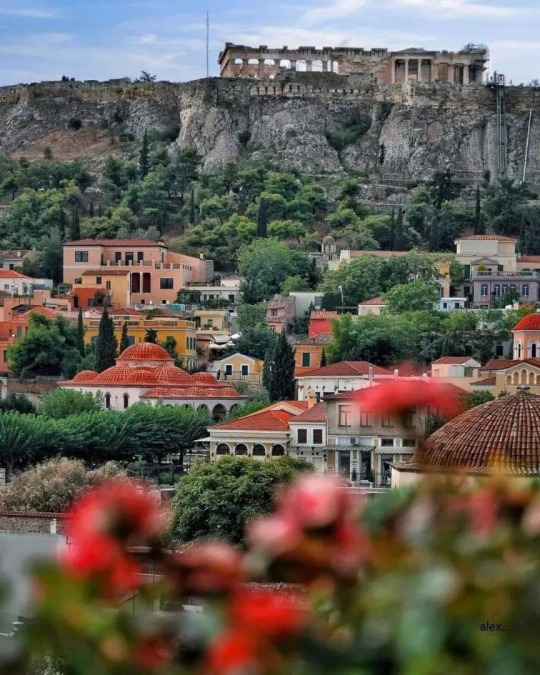
Acropolis from Plaka, Athens by alexandra_petrogiannou on Instagram.
#greece#europe#travel#wanderlust#flowers#acropolis#greek temple#ancient temple#city#architecture#landscape#parthenon#plaka#athens#attica#central greece#sterea hellas#mainland
355 notes
·
View notes
Text

‘Extremely Rare’ Roman Temple Discovered in Italy
Sarsina is a sleepy, rural town of barely 3,000 residents straddling the pristine Apennine mountains in Italy’s Emilia Romagna region, surrounded by stunning views and grazing sheep.
While it has a glorious past, as a strategic defensive outpost for the Roman Empire and the birthplace of the famed playwright Plautus, today there’s not much to do beyond hiking and birdwatching.
And though both locals and holidaymakers would agree that a rustic, slow-paced lifestyle is part of Sarsina’s charm, its residents were nonetheless excitedly awaiting the construction of a development including a new supermarket, fitness center and playground. But it was not meant to be — at least, not as originally planned.
That’s because workers at the site on the outskirts of town in December 2022 unearthed the ruins of an ancient Roman temple — or ‘capitolium’ — dating back to the first century BC.
In early July, a first look at the underground treasure came to light: a single imposing structure of horizontal sandstone blocks and marble slabs, 577 square meters wide, which researchers have identified as the podium above which the columns and walls of an ancient temple were built.
And what has come out of the ground so far could be just the tip of the iceberg.

“We have unearthed three separate rooms, likely dedicated to the triad of gods Jupiter, Juno and Minerva,” lead archaeologist at the excavation site Romina Pirraglia said. “The excavations are still underway… and we have already identified an older, deeper layer of ruins dating back to the 4th century BC, when the Umbrian people (an ancient Italic tribe who predated the Romans) lived in the area. The entire temple could be even larger than what we now see.”
According to Pirraglia, the discovery of a capitolium — the main temple in an important Roman city, and a hub for trade as well as religious and social interactions — further confirms the strategic role Sarsina played during the Roman Empire. The town was built in a key mountainous area close to the Tuscan border and overlooking the Savio river, an important waterway connecting central and northern Roman cities.
The discovery of the temple has pushed local authorities to revise their building plans. Federica Gonzato, superintendent of archaeology, fine arts and landscape for the provinces of Ravenna, Rimini and Forlì-Cesena, which includes Sarsina, is adamant in wanting to preserve the ruins and further research its great past.
“We will not tear it down to make room for modern structures, this must be very clear. Previous urban plans will be changed, we will find new construction sites for recreation and sports,” Gonzato said. “The temple is an incredible finding that sheds light on how ancient Roman towns rose and fell across time.”
What makes the discovery exceptional is the temple’s unique state of preservation. “The marvelous quality of the stones have been spared from sacks, enemy invasions and plunders across millennia thanks to the remote location of Sarsina, a quiet spot distant from larger cities,” Gonzato added. “Temples such as this one (were) regularly plundered, exploited as quarries with stones and marble slabs taken away to be re-used to build new homes. But Sarsina’s capitolium podium structure is practically untouched, with its entrance staircase well-preserved, and this is extremely rare.”

Gonzato believes the discovery will further research on demography and urban transformations in ancient times. And there’s more to the site than just the temple’s podium. Pirraglia said there are signs that the building was reused in medieval times. An ancient water drainage system was found alongside medieval tombs and hearths indicating that locals likely inhabited it, or used the site for other social purposes.
“This is the beauty of Italy: wherever you dig, some hidden treasure comes out of the ground. Wonders never cease to amaze us,” said Gonzato.
By Silvia Marchetti.
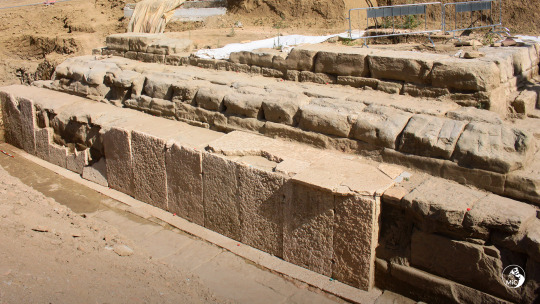

#‘Extremely Rare’ Roman Temple Discovered in Italy#Sarsina Italy#capitolium#ancient temple#ancient artifacts#archeology#archeolgst#history#history news#ancient history#ancient culture#ancient civilizations#roman history#roman empire#roman art
274 notes
·
View notes
Photo

Duthu Ashara temple - Siq al-Barid, 2016
#picofthenight#travel#jordan#original photographers#photographers on tumblr#ancient architecture#nabateans#ancient temple#architecture#canyon#photoofthenight
571 notes
·
View notes
Text
The Lion of Mari, from Syria (Mesopotamia) c.1782-1759 BCE: this is one of two lion statues that once guarded the entrance to a temple in ancient Mari; the lions were partially crushed when Hammurabi laid waste to the city in 1759 BCE
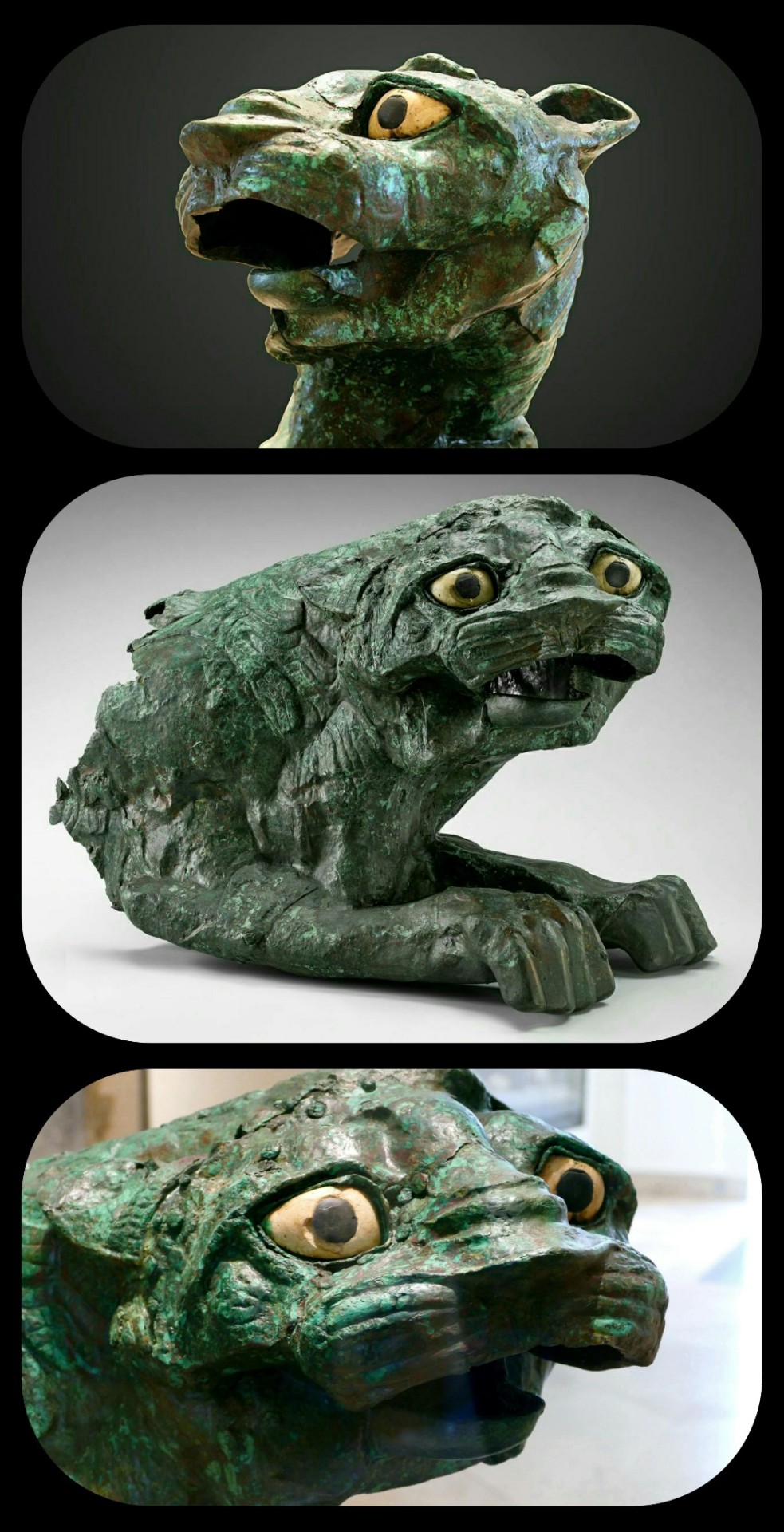
That's a pretty fitting expression, given the circumstances
Together, the two lion statues that were found at the ruined temple are known as the "Lions of Mari." They were unearthed from the ruins at Tell Hariri, where the ancient city-state of Mari once stood; this site is located near the border between modern-day Syria and Iraq.
The lions were likely designed as protomes, given their lack of hindquarters. They were originally stationed on either side of the entrance to the temple, so they are often described as the "temple guardians."

This is the same statue that appears in the first three photos, just seen from a different angle
It's believed that the temple at this site was originally built in honor of a West Semitic deity known as Dagan. Dagan was the chief deity of the Mariote pantheon; he was a particularly prominent figure in the middle and upper regions of the Euphrates, with cult centers in Mari, Terqa, Tuttul, and Ebla, but he was known throughout many parts of the ancient Near East.

The lion is primarily made of copper, with limestone and shale inlay for the eyes, and it measures 53cm tall, 77.5cm long, and 43cm wide, weighing roughly 55kg (about 21in x 30.5in x 17in, with a weight of 121lbs)
The Lions of Mari were partially crushed when their temple was destroyed (along with the rest of Mari) by Hammurabi's forces in 1759 BCE, leaving the statues badly warped...which is why they look really upset.
It's hard to find high-quality photos of the second lion, but he does have a particularly distinctive appearance:

This second lion was most recently housed at the National Museum of Aleppo, in Syria, though its current location/status (in the aftermath of the Syrian Civil War) remains unclear.
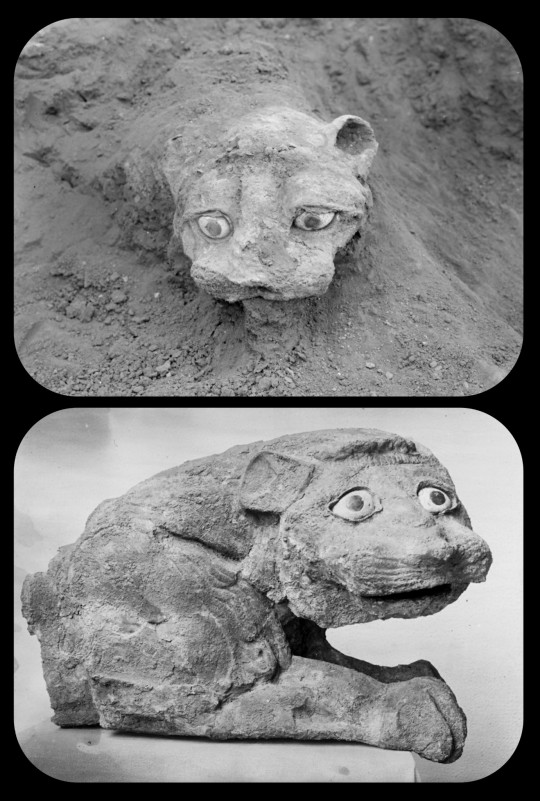
These photographs were taken during the original excavations at the ruined temple; they depict the first lion statue as it was still being unearthed (top) and the second statue shortly after it was removed (bottom)
Sources & More Info:
The Louvre: Lion of Mari
Archeologie.culture.fr: Lion Protome
Archeologie.culture.fr: Detailed Information about Ancient Mari
Virtual Museum Syria: Lion Sculpture
#archaeology#history#artifact#ancient history#art#mari#ancient temple#Syria#mesopotamia#Temple of the Lions#mesopotamian religion#ruins#hammurabi#Tell Hariri#middle east#lion#mesopotamian art#syrian archaeology#paganism#that first lion looks exactly like the way I feel
52 notes
·
View notes
Text
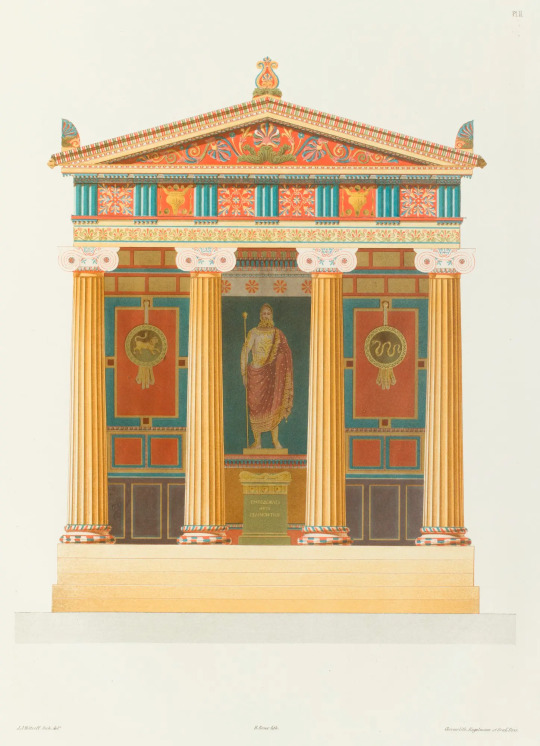


These chromolithographs by Jakob Ignaz Hittorff, a German-born French architect of the 18th century, are based off archeological data from different Ancient Greek ruins. They are meant to show how truly diverse and unique the color patterns of the Ancient Greek temples were - much more unusual than the stark-white of the colorless marble.
While of course this is but one of the options and not at all a definitive picture of the Ancient world, Hittorff made a rather compelling case.
This particular example depicts the main entrance into the temple, its inner cross section, and the side view.
The rest of the collection resides in the Royal Academy of Arts and can be viewed here: 🏺
#ancient history#jacob ignaz hittorff#ancient temple#ancient greece#greek temple#color reconstruction#chromolithography#HISTORIA 📔
51 notes
·
View notes
Text
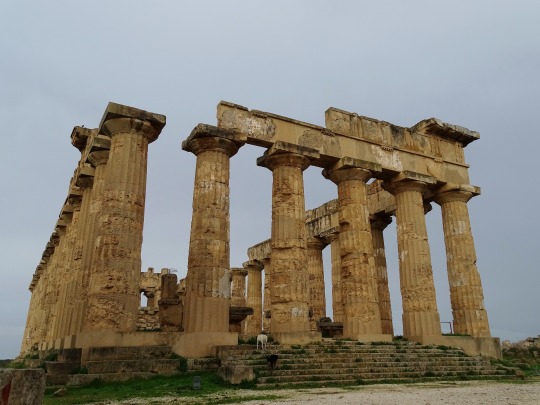

The ruins of the Ancient Greek Temple of Hera in Selinunte, Sicily.
Explore Selinunte:
#Selinunte#ancient greek#ancient temple#temple#explore#architecture#travel#history#greek#ancient ruins#ruins#sicily#sicilia#italia#italy#original photography#photographers on tumblr#my pics#archaeology#ancient architecture#wanderingjana#photography
26 notes
·
View notes
Text

I was asked once why I chose to teach history. This was my reply.
Photo was taken by me at Göbekli Tepe, one of the oldest Neolithic archaeological site in the world. This is classified a UNESCO World Heritage site.
A belated post for World History Day, which was exactly two weeks ago, Nov. 17th.
#poets on tumblr#onurtaskiran poetry#gentleman poet#poets and writers#romantic writer#ancient world#ancient history#gobekli tepe#mesopotamia#neolithic#history#history professor#history lover#visit türkiye#ancient temple#fascinating#discovery#world history#world history day#heritage
115 notes
·
View notes
Text
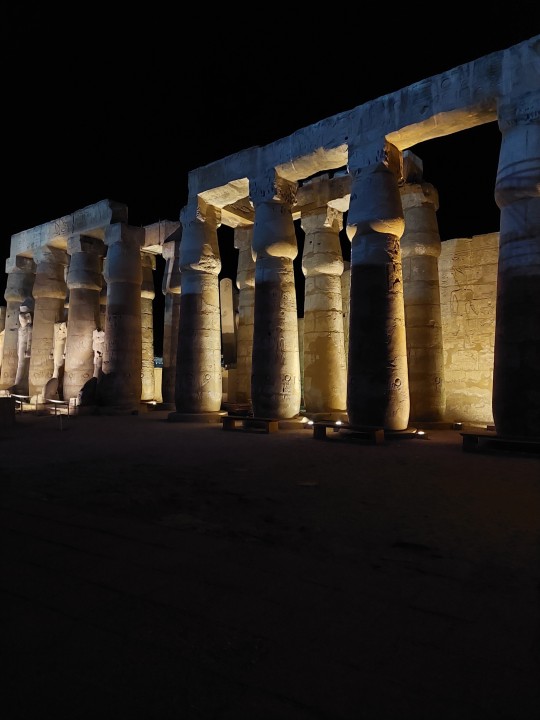
#mine#my pictures#my picture#photography#my photography#amateur photography#egypt#ägypten#egypte#luxor#luxor temples#luxor temple#egyptian temple#egyptian#night#nighttime#night photography#ancient temple
8 notes
·
View notes
Text
536 notes
·
View notes
Photo

Children hanging out in a neighbourhood near the Acropolis, Athens 1959.
Photo by K. Lignos.
From the archive of Anastasia Mihala.
#greece#europe#acropolis#ancient ruins#ancient temple#places#kids#greeks#greek people#old photos#black and white#athens#sterea hellas#central greece#attica#mainland
26 notes
·
View notes
Text

Archaeologists Discover 11,000-Year-Old Statue Clutching His Genitals in Turkey
Archaeologists in Turkey have unearthed a nearly 11,000-year-old statue that may depict a giant man clutching his penis, along with a life-size wild boar statue. The two statues come from the neighboring sites of Gobekli Tepe and Karahan Tepe, which are among the oldest temple sites in the world.
The wild boar statue, which is carved from limestone, was found at Gobekli Tepe and dates to between 8700 B.C. and 8200 B.C. It measures 4.4 feet (1.4 meters) long and 2.3 feet (0.7 m) high, the German Archaeological Institute said in a statement. Archaeologists detected red, black and white pigments on its surface, indicating that the sculpture was once painted. Archaeologists unearthed the large sculpture of the manat the site of Karahan Tepe, about 22 miles (35 kilometers) from Gobekli Tepe. It depicts a 7.5-foot-tall (2.3 m) man, according to a translated statement from Turkey's ministry of culture and tourism. The person's ribs, spines and shoulders are particularly pronounced, and the person may actually be depicted as being dead, the statement said.

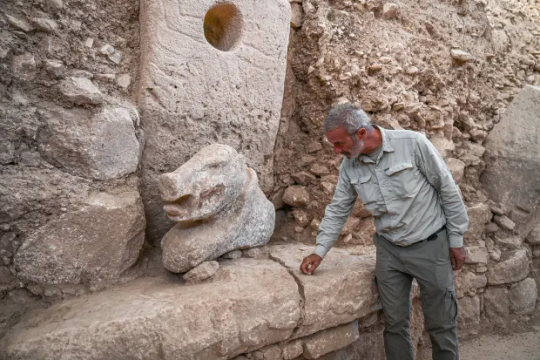
These discoveries, "represent the latest spectacular finds from these sites which are transforming our understanding of pre-agricultural communities," Benjamin Arbuckle, an anthropology professor at the University of North Carolina at Chapel Hill who was not involved with the excavations, said in an email.
Researchers also found a small sculpture of a vulture nearby at Karahan Tepe. While archaeologists didn't say how old the newfound statues at, Karahan Tepe are, the site is around 11,000 years old and contains other sculptures and buildings.
The purpose of the recently found sculptures is unclear. "The Karahan Tepe finds strike me as the most interesting," Ted Banning, an anthropology professor at the University of Toronto who is not involved with the research, said in an email. "Any interpretation of the statue is conjectural at this point," Banning said but suggested it was likely that the person shown is dead. It may represent "an important ancestor associated with the building in which it was found."
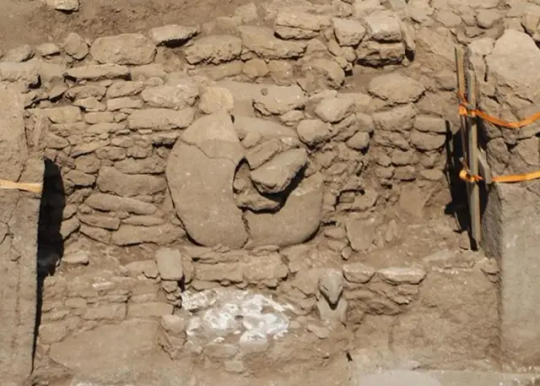
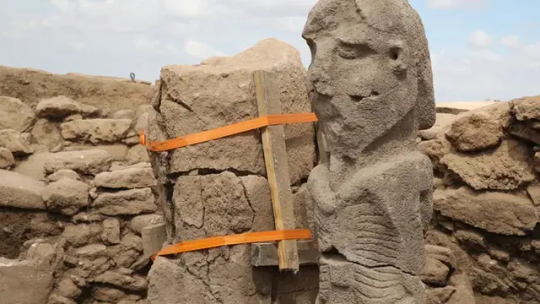
The figure's pose may give a further clue about its purpose. "The fact that the figure is clutching its penis is also consistent with this interpretation by potentially symbolizing that this person was the progenitor of a social group, such as a lineage or clan, associated with the building," Banning said.
Banning thinks that structures at Karahan Tepe and Gobekli Tepe may have been used as houses rather than temples, "in which case it makes a lot of sense that each would have its own lineage ancestor," Banning said.
It's not surprising that the wild boar sculpture has pigments, he added. "I think it's plausible that much or even most of the sculpture at these sites was originally painted", Banning said, noting that paint doesn't preserve well in the archaeological record.
By Owen Jarus.
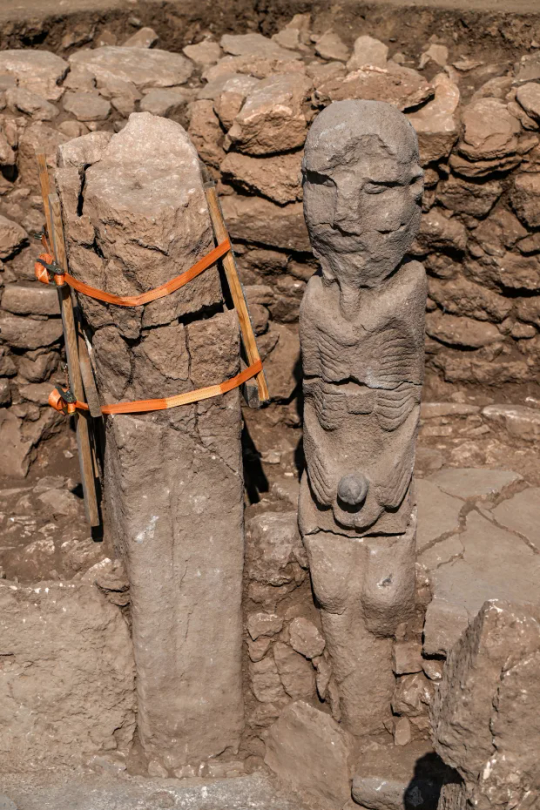


#Archaeologists Discover 11000-Year-Old Statue Clutching His Genitals in Turkey#Karahan Tepe#Gobekli Tepe#temple#ancient temple#ancient artifacts#archeology#archeolgst#history#history news#ancient history#ancient culture#ancient civilizations
76 notes
·
View notes
Text

Kyoto, 2011
#picoftheday#travel#japan#original photographers#photographers on tumblr#street photography#japanese aesthetic#urban landscape#ancient architecture#japanese architecture#ancient temple#street life#photooftheday
22 notes
·
View notes
Text

21. River
The hidden blade at the Source of the flow.
15 notes
·
View notes
Text
youtube
#ancientegypt#egyptology#Edgar Cayce#archaeology#pyramids#sphinx#documentary#ancient gods#ancient temple#hidden knowledge#mysticism#initiation#occult wisdom#inner transformation#egypt travel#ancient civilizations#ancient ruins#ancient history#ancient origins#Youtube
19 notes
·
View notes
